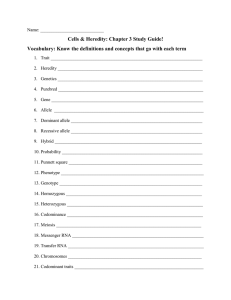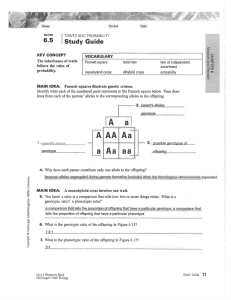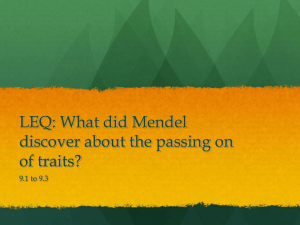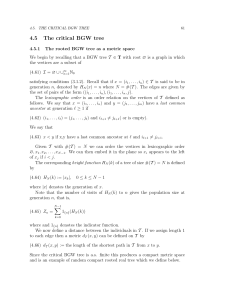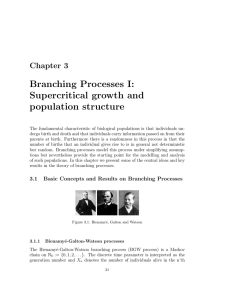EXERCISES for PIMS Course on Stochastic Poulation Systems
advertisement
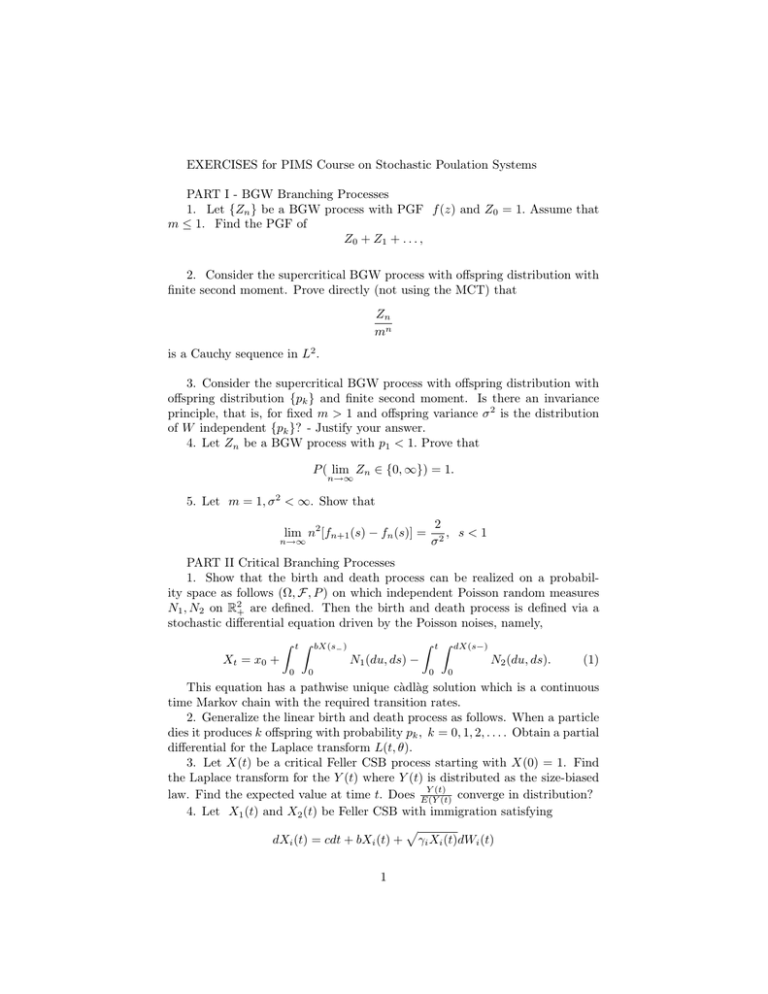
EXERCISES for PIMS Course on Stochastic Poulation Systems
PART I - BGW Branching Processes
1. Let {Zn } be a BGW process with PGF f (z) and Z0 = 1. Assume that
m ≤ 1. Find the PGF of
Z0 + Z1 + . . . ,
2. Consider the supercritical BGW process with offspring distribution with
finite second moment. Prove directly (not using the MCT) that
Zn
mn
is a Cauchy sequence in L2 .
3. Consider the supercritical BGW process with offspring distribution with
offspring distribution {pk } and finite second moment. Is there an invariance
principle, that is, for fixed m > 1 and offspring variance σ 2 is the distribution
of W independent {pk }? - Justify your answer.
4. Let Zn be a BGW process with p1 < 1. Prove that
P ( lim Zn ∈ {0, ∞}) = 1.
n→∞
5. Let m = 1, σ 2 < ∞. Show that
lim n2 [fn+1 (s) − fn (s)] =
n→∞
2
, s<1
σ2
PART II Critical Branching Processes
1. Show that the birth and death process can be realized on a probability space as follows (Ω, F, P ) on which independent Poisson random measures
N1 , N2 on R2+ are defined. Then the birth and death process is defined via a
stochastic differential equation driven by the Poisson noises, namely,
Z tZ
bX(s− )
Z tZ
N1 (du, ds) −
Xt = x0 +
0
0
dX(s−)
N2 (du, ds).
0
(1)
0
This equation has a pathwise unique càdlàg solution which is a continuous
time Markov chain with the required transition rates.
2. Generalize the linear birth and death process as follows. When a particle
dies it produces k offspring with probability pk , k = 0, 1, 2, . . . . Obtain a partial
differential for the Laplace transform L(t, θ).
3. Let X(t) be a critical Feller CSB process starting with X(0) = 1. Find
the Laplace transform for the Y (t) where Y (t) is distributed as the size-biased
Y (t)
law. Find the expected value at time t. Does E(Y
(t) converge in distribution?
4. Let X1 (t) and X2 (t) be Feller CSB with immigration satisfying
p
dXi (t) = cdt + bXi (t) + γi Xi (t)dWi (t)
1
where W1 , W2 are independent Brownian motions. Derive the SDE’s for the
pair
(Y (t), Z(t))
(t)
where Y (t) = X1 (t) + X2 (t), Z(t) = XY1(t)
up to the time of extinction of Y (t).
5. Prove that
dGH (Tg , Tg0 ) ≤ 2 k g − g 0 k .
(2)
PART III - Wright-Fisher and Infinitely many alleles processes
1. Consider the Kingman coalescent process, that is, the pure death process
with death rate
dk = k(k − 1).
Prove that there exists an entrance law from infinity (”coming down from
infinity”) , that is, an integer-valued process with these death rates, {K(t) : t ≥
0} such that
lim K(t) = ∞.
t↓0
2. Construct the Kingman coalescent as a compact random metric space.
3. Let X be the stationary infinitely many alleles model with uniform
mutation law. Extend its time parameter set to (−∞, ∞).
(a) Show that {X(t) : −∞ < t < ∞} and {X(−t) : −∞ < t < ∞} induce
the same distribution on CP ([0,1]) (−∞, ∞).
(b) Using (a), show that the probability that the most frequent allele at time
0, say, is oldest equals the probability that the most frequent allele at time 0
will survive the longest.
4. Show that the distribution of sizes of the age ordered alleles in the infinitely many alleles model is given by the GEM distribution. Use this to find
the mean frequency of the jth oldest allele in the population.
PART IV - MISCELLANEOUS
1. Consider a two level branching process. The level two objects is a binary
BGW process and each level two object consists of a number of level one objects.
Within each level two object the level one objects form a binary BGW process.
When a level two object produces offspring they begin with the number of
particles in the parent object. Model this as a branching Markov chain. Obtain
an equation for the log-Laplace equation.
2. Prepare an exposition on the Gromov-Hausdorff metric and metric measure spaces.
2

